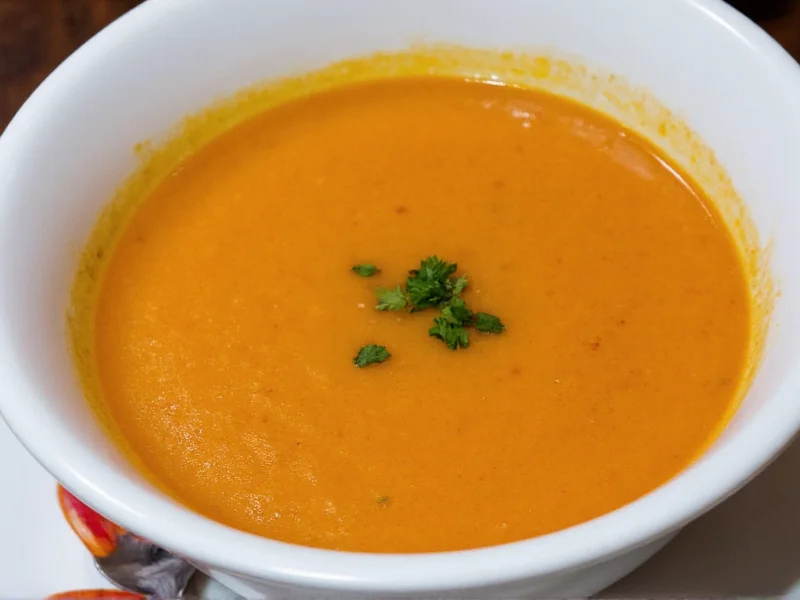A bisque stands apart from other soups through specific culinary techniques and characteristics that define its luxurious texture and rich flavor profile. Understanding what makes a soup a bisque requires examining both historical traditions and modern interpretations of this classic preparation.
Historical Origins of Bisque
The term “bisque” derives from the French “bisque de homard,” meaning “lobster bisque.” Originally, bisques were created by French chefs who developed a method to extract maximum flavor from shellfish shells. They would crush lobster, crab, or shrimp shells and simmer them to create a rich stock, then puree the entire mixture to achieve an exceptionally smooth texture. This traditional bisque preparation method transformed what might have been waste products into a luxurious dining experience.
Defining Characteristics of Authentic Bisque
Several key elements distinguish a true bisque from other soup varieties:
Texture and Consistency
The most defining feature of bisque is its velvety smoothness. Unlike chunky soups or even some cream soups, bisque contains no visible particles. This smooth bisque texture is achieved through meticulous pureeing and fine straining, often passed through a chinois (conical sieve) multiple times. The resulting consistency should coat the back of a spoon without running off immediately.
Thickening Techniques
Traditional bisques used ground shellfish shells as a natural thickener, which also contributed to the distinctive flavor. Modern preparations typically use one of three methods:
| Thickening Method | Traditional Use | Modern Application |
|---|---|---|
| Shellfish shells | Crushed shells simmered in stock | Rarely used today due to texture challenges |
| Rice | Added during cooking, then pureed | Common thickener that adds subtle sweetness |
| Cream | Added at the end of preparation | Standard in modern bisques for richness |
Culinary Process
The authentic bisque cooking process involves multiple precise steps:
- Sautéing aromatics and main ingredients
- Simmering to develop deep flavors
- Pureeing the mixture until completely smooth
- Straining through a fine mesh sieve
- Finishing with cream and careful seasoning
Bisque vs. Other Soup Types
Understanding how to identify a true bisque requires comparing it to similar preparations:
Bisque vs. Cream Soup
While all bisques are cream soups, not all cream soups are bisques. The critical difference lies in texture and preparation. Cream soups may contain small vegetable pieces and use roux or cornstarch for thickening, while bisques must be completely smooth with no visible particles and use more specialized thickening techniques.
Bisque vs. Chowder
Chowders feature chunky ingredients, potatoes, and a milk or cream base, but maintain visible components. Bisques, by contrast, are uniformly smooth throughout. The difference between bisque and chowder is immediately apparent in both texture and presentation.
Bisque vs. Puree Soup
Puree soups are simply blended until smooth, but may lack the richness, careful straining, and finishing techniques that define bisque. A tomato puree soup isn't automatically a bisque unless it follows the specific preparation methods and achieves the characteristic luxurious texture.
Modern Interpretations and Variations
While traditional bisques were exclusively shellfish-based, contemporary chefs have expanded the concept to include vegetable bisques like tomato bisque, mushroom bisque, and pumpkin bisque. These vegetable bisque preparations maintain the essential characteristics of smooth texture and rich flavor while adapting to different ingredients.
The key to successful vegetable bisques lies in replicating the richness traditionally provided by shellfish. Chefs accomplish this through careful caramelization of vegetables, strategic use of fats, and sometimes incorporating small amounts of shellfish stock or alternative umami boosters.
Common Misconceptions About Bisque
Several myths persist about what defines a bisque:
- Misconception: All cream-based soups are bisques
- Reality: Texture and preparation method matter more than the presence of cream
- Misconception: Bisque must contain shellfish
- Reality: While traditional, modern bisques frequently use vegetable bases
- Misconception: Bisque is simply a fancy name for any smooth soup
- Reality: Specific preparation techniques distinguish authentic bisque
Creating Authentic Bisque at Home
Home cooks can achieve restaurant-quality bisque by focusing on these essential elements:
- Take time with the initial sauté to develop flavor foundations
- Simmer gently to extract maximum flavor without boiling
- Puree thoroughly using high-powered blenders
- Strain meticulously through fine mesh sieves
- Finish with quality cream and precise seasoning
The proper bisque consistency test involves drawing a line through the soup on a plate—it should hold its shape briefly before slowly filling in. This “nappe” consistency indicates perfect thickness for a bisque.











 浙公网安备
33010002000092号
浙公网安备
33010002000092号 浙B2-20120091-4
浙B2-20120091-4